What Are The Best Sciatica Exercises To Relieve Pain?
As painful as sciatica is, it’s not something that can’t be overcome. Are there any exercises to relieve sciatica pain?
Yes there are! Here, I’d like to show you the top 15 exercises and stretches that I’ve personally use to get fast relief.
And best of all, these exercises can prevent occurrences of sciatica pain in future – as long as you’re doing it continuously.
In this article, I’m going over my personal 11 best sciatica exercises to relieve pain that I’m sure will help you.
Interested? You should be. Read on!

Hi there, my name is Isaac and I’m one of the thousands of guy that was unfortunate to be a victim of slipped disc and sciatica.
The cause? An improper form while lifting weights. Suffice to say, my back was never the same after that unfortunate day.
As you might know now, slipped disc or bad back is one of the main cause for sciatica pain. The protruding spinal disc material can impinge on the nerve causing debilitating pain whenever I least expected it.
It was very tough as my daily life was never the same again. I did went to chiropractor and physiotherapy but I realized soon those sessions costs lots of money.
I began to find ways on how to treat sciatica pain on my own. And these 11 sciatica exercises are some of the best that I felt had worked for me in curing my sciatica pain.
So try to do these exercises diligently and I promise you’ll be able to feel the difference even from the first session.
 By the way, I learned all of these exercises from this Sciatica SOS ebook.
By the way, I learned all of these exercises from this Sciatica SOS ebook.
It’s a great all-in-one ebook comprising all the information you could need to know about sciatica and how to cure it.
It has helped me a lot in my own journey and I can’t recommend it highly enough. By the way, there’s currently a great discount on the ebook so you might want to take advantage of that (click here to check if the discount is still available).
Here Are The 11 Sciatica Exercises To Relieve Pain:
- Hamstring Stretch
- Piriformis Stretch
- Standing Back Extension
- Back Flexion
- Upper Back Extension Exercise
- Straight Leg Raise
- Hook-lying March
- Bridging
- 4 Point Kneeling Exercise for Sciatica
- Lumbar Rotation Exercise
- Aerobic Conditioning – Light Jogging
A Word Of Warning Before We Start
One thing that I would like to point out is these exercises should bring relief and you should NOT FEEL PAINFUL at all when doing it.
If you’re feeling pain (the bad kind of pain, not the relief kind of pain..), then STOP IMMEDIATELY.
In this case, there are two possible causes. One, you’re not doing it right. Please look at the pictures and find videos on youtube. Then try to get someone to check your form or you can look at yourselves in the mirror. It is very important that you’re doing the exercises correctly to avoid injuring yourselves.
Secondly, it is also possible that the specific exercise is not compatible with your condition as the injury differs from person to person. Something that works for me might not work for you.
For example, the yoga cobra pose was highly regarded as the back pain killer by many but I always felt it’s painful for me to do – perhaps it’s because of my specific injury.
Bottom line is, try to do these exercises correctly and safely. If you still feel any pain even when you thought your form is perfect, then that exercise might not be compatible with your body in which case you need to stop doing it.
Remember, pain is a way for our body to tell us there’s something wrong. So never neglect it and adjust what you’re doing accordingly.
1- Hamstring Stretch
 Standing hamstring stretch
Standing hamstring stretch
I’m going to start this list with my personal favorite: the hamstring stretch. Hamstring muscles are the muscles at the back of our legs and are actually surrounding the nerve along our legs.
So a tight hamstring due to modern sedentary lifestyle (aka lots of sitting) will make it shorten. This situation is bad for our backs because it places more stress on it.
Doing the hamstring stretch will help lengthen the muscles again and reduce stresses on your back. This stretch, with the piriformis stretch (next up) are a great combination to combat piriformis syndrome and sciatica.
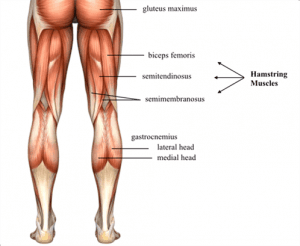 Hamstring consists of several muscles behind our thigh
Hamstring consists of several muscles behind our thigh
The hamstring stretch has many variations. The first picture above is the standing hamstring stretch that I like to do mainly because it can be done anywhere without me having to sit down.
You can also do the seated hamstring stretch (picture below) for even greater stretch.
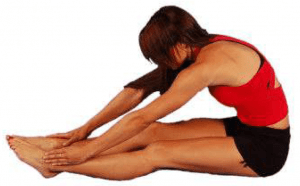 Seated hamstring stretch
Seated hamstring stretch
If you’re still fresh off a back injury, then I would suggest for you to do the standing variation as the seated variation can be a bit challenging for your back.
Another added benefit of doing the stretch is it will increase your flexibility – which means you can bow down lower.
2- Piriformis Stretch
The second sciatica exercise or stretch that I frequently because it helps so much with sciatica is piriformis stretch. It’s one of the helpful exercises that you can do to relieve your sciatica pain.
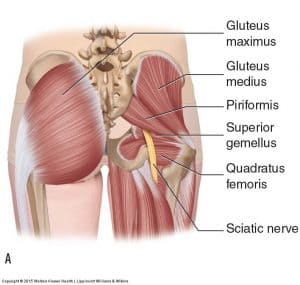
Piriformis muscle is the underlying muscle connecting our backbone to our leg bones. The thing is, the sciatic nerve (of which is our prime concern) is located very near to this muscle.
So as you can expect, if the muscle is too tight from all that sitting AND inflammed due to injuries, the muscle will impinge on the sciatic nerve causing sciatica pain.
What you can do is to avoid sciatica pain is by stretching the piriformis muscles with the right exercise. Done correctly, it will relieve your sciatica pain and will also make your hips feel better.
Ever getting tired and sluggish after hours of sitting?
This stretch is a great way to correct that. In fact, I’ve loved this stretch because it makes me feel a lot better by releasing stresses around my hip region.
How to stretch your piriformis?
The best way is to lay down on your back and bring your feet towards your chest. There’s a few variations but the one in the picture below is what I usually do as it gives a deep stretch on piriformis muscle.
You really should give it a try!
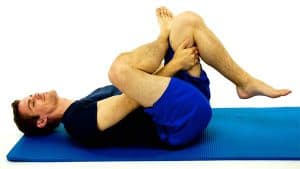
Piriformis Stretch
3- Standing Back Extension
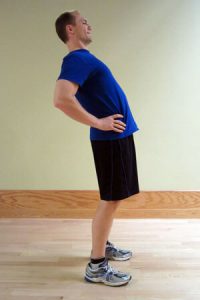
The next exercise is something that will really help, especially if you’re someone that sits a lot – the back extension exercise.
Most of the time, people suffering from slipped disc or other back injury will have the spine impinging on the nerve at our back causing sciatica pain.
In addition to that, long hours of sitting and hunching forward puts greater stress on our back, and further aggravates the situation.
So what I normally do is after one hour (or it could be shorter, depending on your tolerance level) sitting doing my job, I’ll stand up, put my hands on my back, and push forward my hip while keeping my upper body backwards.
It’s a really fast and effective stress reliever, not just for sciatica pain but for back pain in general. The best part of all, it can be done anywhere because you don’t have to sit or lay down on the floor like the other exercises.
4- Back Flexion
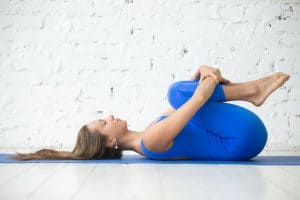
Contrast with the back extension, the back flexion seeks to stretch the back muscle area by pulling your legs towards your chest in a lying down position.
This is actually similar to the piriformis stretch above but the effect is different. While the piriformis stretch targets the deep lying piriformis muscle, the back flexion targets the whole muscles at our back around the spine.
As soon as you do this you’ll notice a huge relieve of stress and pain around the back area. What’s happening is this position will stretches the muscles around the back region – the same muscles that is overworked trying to keep hold our spine and body whenever we’re sitting or standing.
You can also do the standing variation of this back flexion by trying to reach your toes when standing. But based on my personal experience, the standing back flexion exercise is a very bad exercise for those with lower back pain.
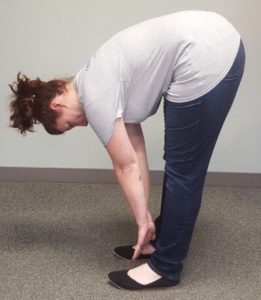
While the standing back flexion looks the same as the seated version, it also put a huge stress on our back. It’s NOT RECOMMENDED for those fresh off a back injury
The standing back flexion is not for everyone. You can give it a try but I bet those with lower back problem will find it to be a painful exercise instead of relieving your pain. NOT RECOMMENDED for everyone.
I tried it a few times based on recommendations from others but I have always felt huge sensation of pain when trying to do it (even though it looks just like the lying back flexion..).
Which is why I highly recommend that you don’t do the standing back flexion and only stick to the lying one.
5- Upper Back Extension Exercise
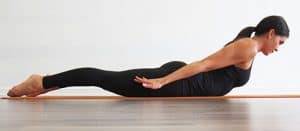
The next exercise that can help with sciatica and back pain is the upper back extension exercise.
While the back extension in Exercise #3 above is more towards stretching and relieving stresses around the lower back, this particular exercise is targeted to strengthen the back muscle.
This is very important as a strong back muscle can help to stabilize the spine better, lowering stresses around your back, and help prevent future occurrence of sciatica pain.
Start by lying on your front body. Then lift the head and chest slightly upwards while keeping your head straight with your spine. A way to do this is by keeping your eyes on the floor.
You’ll notice that in order to do this, your upper back need to be engaged and active to bring your upper body up.
As with any other exercise, try to get that good contraction feeling on your upper back while doing this. This will help to maximize the result from this exercise.
6- Straight Leg Raise
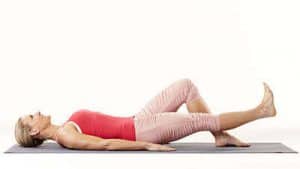
The next exercise is the straight leg raise, designed to target lower abs muscle. While lying on your back with both knees bend, try to raise one of your legs up – keeping it straight in the process.
As with the upper back exercise, you’ll realize that you need to engage the abs to work in order to do this.
7- Hook-lying March
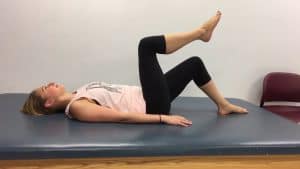
After the leg raise, we’ll go into an exercise called hook-lying march. It’s still targeting the lower abs but with different movement pattern. Instead of a static exercise, this one is a bit more dynamic.
Starting on the same lying on your back position with knees bend, lift your legs up one at a time. Once both legs are up, slowly lower it down to the floor.
The trick here is to lower down the legs slowly. You’ll notice that lifting your legs up does not use much muscle but when you’re lowering both legs down, the abs are engaged to keep your body stable.
Lowering the legs down slowly will increase the effort by your abs muscle, making the exercise more efficient in working it out.
It’s a bit hard to understand by reading so I’ve included a video below for you to learn how to do this.
8- Bridging
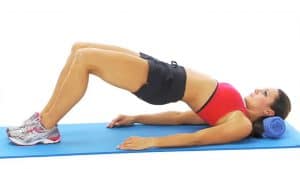
Bridging is an exercise that I like because not only it strengthen the core, but also because of the stress relieving effect from the movement.
Firstly, lie down on your back with knees bend. Then lift up your buttocks off the floor and try to make your body in a straight line like the picture above.
How to know you’re doing a good bridge?
If you feel your lower abs and lower back are activated, then you’re doing a good job. You will need to engage your core areas to maintain the bridge body posture, otherwise the exercise won’t achieve its purpose.
This exercise is also a good way to give you a feeling of how a good core muscle activation is. It’s difficult to put in writing but in summary, it’s the feeling of keeping your core tight – from front to back.
Now, once you’ve felt that, I recommend that you try to engage your core the same way while sitting and standing.
You’ll notice that suddenly your lower back pains will go away. That’s the effect from your tight core reducing the stress off your lower back. And doing this consistently will greatly help with your lower back and sciatica pain.
That kind of tight core is the key to maintain a good posture while standing or sitting. And the bridging exercise here is a great way to help you to learn just how to do that.
9- 4 Point Kneeling Exercise for Sciatica
 Beginner form of the 4 point kneeling exercise
Beginner form of the 4 point kneeling exercise
Next up in this list of sciatica exercises to relieve pain is another core stabilization exercise that I love is the 4 Point kneeling exercise. It’s similar to the bridging in which we’re targeting to keep the core stable, but in a kneeling position.
To start, make a 4 point kneeling position (the 4 points are the 2 palms and 2 knees supporting the body).
The natural tendency of our body in this position (especially for those suffering from back problems) is to arch the lower back downwards.
So what we should do is to try to keep our body straight. This is achieved by engaging our core muscles (front abs and back) and pull our gut – just like the bridging exercise above.
In doing so, we’re training our core to keep steady and strengthening it, helping to reduce lower back pain and prevent further sciatica occurences.
This exercise also has an awesome advanced version that I recommend you to do. Well, the truth is the beginner version is quite easy to do and the advance version works the core lots more.
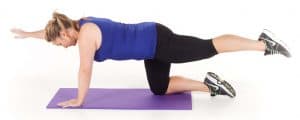 Advanced form of the 4 point kneeling exercise
Advanced form of the 4 point kneeling exercise
You’re going to take it a bit further by lifting up either your hand, your leg or both of them at the same time. The key here is to keep the trunk stable without any twisting or sagging even when the hand/leg is lifted up.
Below is a video showing you how to do it correctly:
So what I normally everyday now is to do the beginner version first for a couple of reps (holding it for 10-20 seconds at a time). This is to ensure that I got the basics of keeping my core tight correctly.
Once I’m satisfied, then I will progress into the advanced version by first lifting up my hand, then my leg.
After a few reps, then I’ll progress into the last form that is lifting up both an arm and a leg simultaneously (like in the video above).
10- Lumbar Rotation Exercise
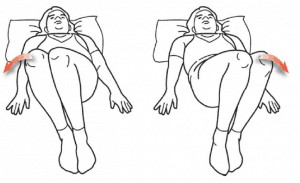
Next one is something that will work wonders especially after a long day at work. The lumbar rotation exercise is a great exercise to loosen up your hip region that can be tight after hours of sitting, standing and walking.
Well, actually living a day is a bane for us lower back pain sufferers so this exercise is a great way to help release stresses around our hip and pelvic region.
Start by lying down and bending our knees. Then move the knees to the right and left while keeping your back stable.
As you rotate your knees, feel your hip rotates, which in turn will give some really great relief on your hips. Trust me, it works really well!
11- Aerobic Conditioning – Light Jogging
The last exercise that you can do to relieve sciatica pain is aerobic conditioning. While the primary objective of aerobic conditioning is to improve our cardiovascular system (the blood flow from our heart around our body), sciatica pain sufferers will greatly benefit from the movement of our body.
The other exercises above are great to help stretch and strengthen our body, specifically the core area that is very important from where sciatica pain originates.
But I’ve learned that those are not enough for us. Our body still need to move a lot more for it to be trained and become stronger. And the best way to do so without putting too much stress on it is with a light jogging.

Well, in theory, you could do many other activities such as marathon, cycling or swimming. But as a lower back pain sufferer, I noticed that these activities are a bit too much for me.
For instance, cycling tend to put me in an extreme forward flexion position that’s not good for my back (because I felt pain afer just a few minutes of doing it).
I love swimming but I feel that it don’t really work the core region as much as jogging which moves the legs a lot more.
Light jogging is one of the best aerobic conditioning a sciatica sufferer can do because it’s not too hard on your body (which is why I stressed the “light” part) while also giving the benefit of moving your body.
What I do now is having a quick 15 minutes jog at moderate speed.
Why 15 minutes?
Because it’s a long enough jogging session to challenge my body into giving out sweat. I don’t go over 15 minutes because I don’t want to put too much stress on my back. When you have sciatica and lower back pain, it’s important to do everything in moderation LOL!
As always, try to keep your core tight when jogging. You’ll be amazed at how it helped to take off stresses over your back and lessen the pain while you jog.
 Before I end this post, I would like to let you know that I learned all of these exercises from this Sciatica SOS ebook.
Before I end this post, I would like to let you know that I learned all of these exercises from this Sciatica SOS ebook.
It’s a great all-in-one ebook comprising all the information you could need to know about sciatica and how to cure it. It has helped me a lot in my own journey and I can’t recommend it highly enough.
By the way, there’s currently a great discount on the ebook so you might want to take advantage of that (click here to check if the discount is still available).
Final Words
Exercises and stretches are very important to help with sciatica pain and lower back pain. Period. While medication and surgery can help to some extent, it won’t have lasting effect.
For a long term pain free result, a consistent exercise and stretching regime is needed. Besides, I’m sure your doctor/physiotherapist will recommend you to do these exercises too LOL!
Another thing that I would like to stress is the importance of doing these exercises consistently. If you would like a pain free life, then you will need to do these exercises throughout your life. For me, I make sure I’m doing it at least three times per week.
It might seems too much (especially for those that don’t do exercises at all) but think about this – as you grow old, your body will weaken and these exercises and stretches will not only help with sciatica pain but also strengthen your body.
As a result, you won’t have the same “old body” as the others – no slouching, no hunching, can still walk tall, etc. Life is a marathon, so a consistent strategy is needed =)
I really hope this article about the 11 best sciatica exercises to relieve pain will be helpful to you. If you have any questions or comments, put it down below and I’ll get back to you ASAP.
Cheers!
Isaac.

I’ve seen physiotherapist & chiropractic specialist & nothing seems to work! I cannot sit for long periods when my left butt experiences excruciating pain.Some days I cannot walk…I have a fear of loss of mobility and the dependence on my family!These exercises are best for the treatment of the sciatica pain.
Hi buddy. I’m sorry to hear about your condition. How is it right now? Did your condition became better after doing these exercises?
I’ve learnt a great deal from this. Thanks for the comprehensive article! I’ve just did my first exercises using these and i can immediately feel the difference. Will do it again tomorrow until my sciatica pain stopped completely
Hi Hal. It might take a few days for the sciatica pain to stop completely but I believe you should feel a reduction in the frequency. Do update me on your progress and let me know if there’s anything that I can help you with.
Best exersice for sciatica pain Lift your left leg and place your right ankle on top of the left knee. Hold the position for a moment. This helps stretch the tiny piriformis muscle, which sometimes becomes inflamed and presses against the sciatic nerve, causing pain. Do the same exercise with the other leg.
Hi Tikkay. I’ve tried it just now and it really helps with stretching my legs. Thanks for this stretching!
Hi Isaac. Just wondering if there’s any only one exercise that you can do, which one would you pick that can help the most with sciatica?
Hi Jerome. Without a doubt, doing all 11 will do wonders not only for your sciatica pain, but also for general well-being and lower body health. But I do understand your question – as a busy working guy myself, it’s hard for me to find time to do these exercises daily. But at the very least, I will try to do the Hamstring Stretch at least once a day as I felt that it really helps to prevent muscle spasms around the sciatic nerve. Plus, it’s easy to do as you don’t have to sit on the floor like the other exercises.
Nice Blog, it is very helpful to us
Hi Sagar. Thanks for dropping by. Do you have any favorite exercise for sciatica pain treatment?
I really love this exercise list of yours isaac. I’ve done quite a few of them and can immediately feel the difference quite fast. I’m thinking of buying the sciatica sos book but am afraid that it won’t do any good. what do you think?
Hi Jagdid. I’m glad that you’re experiencing positive effect from these sciatica exercises and able to relieved your pain.
These sciatica exercises is a good start in your journey but to heal sciatica completely and holistically inside-out, I highly recommend that you grab a copy of the Sciatica SOS ebook. It has all that you need to know about sciatica pain with various methods and tips to relieve the pain (including more exercises of course). Hope that helps and do let me know if you need further clarifications =)
Read all the info on sciatica exercises. Been in a lot of pain for 3 weeks. Am taking medication now but want to know when I should start these exercises.
Hi Jerri. I’m sorry with your condition. It must be very hard as you can’t move as you normally can (been there too…). It’s hard to say which of these exercises that you should do as everyone’s conditions are different.
However, my recommendation is to try to do the exercises (all of them, one at a time) but starting with a short range of motion. For example with the 1st exercise (hamstring stretch), try to lift your leg perhaps only a foot high. If you feel relieved without any sort of pain (it’s good if you’re not on painkillers while doing this) then you can lift your leg higher. Same principle goes with the other 10 exercises.
The key here is to constantly be in touch with how your body feel when you do certain exercises at certain range of motion. If you do feel pain, try to reduce the range of motion up to the point where you feel good.
Best of luck and do let me know if you have further questions =)
There are some conditions in which sciatica requires back surgery, usually due to herniated and/or ruptured disc issues as I understand it. Would you still recommend these exercises while pending a surgery date?
Hi Christi. If the patient’s condition is very bad (e.g bedridden) then I don’t think he/she is in any shape to do these exercises and perhaps surgery will be the best option (depends on the doctor supervising the patient of course).
But if he/she still able to walk and move about, then these exercises are definitely something that the patient should do as it will ease the tightness around the hip/thigh region. This will help him/her to ease the sciatica pain, and maybe perhaps the surgery might not be needed afterwards.
However, I’d advise to start slow with these exercises e.g using short range of motion and always be aware of how the body responds. If the pain dissipates when AND after you did these exercises, then that particular exercise is suitable for you.
But if you feel any sharp pain during OR after the exercise sessions, then that exercise might not be suitable for your body. The key here is to make sure your exercises are helping you feel better and not the opposite.
Do let me know if you have further questions Christi =)
These exercises were instrumental in getting me through a bout of sciatica last year. I did them a number of times every day to try to alleviate the pain. Thank you so much for publishing them.
Hi Mary. Great to know that! Now, don’t forget to occasionally do the exercises in future as sciatica might rear its ugly head from time to time =)